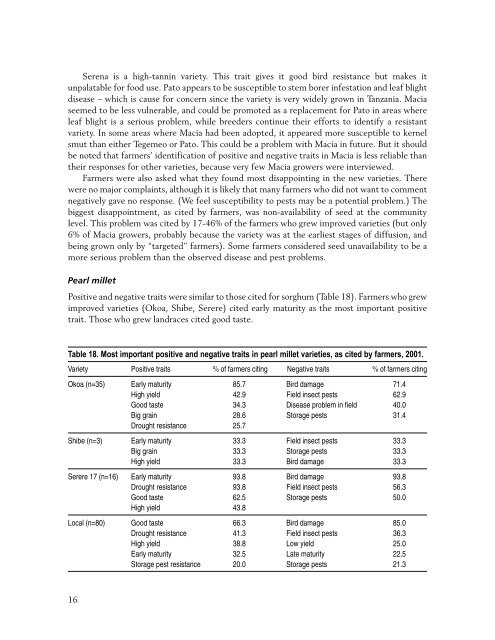Adoption of Improved Sorghum and Pearl Millet ... - Icrisat
Adoption of Improved Sorghum and Pearl Millet ... - Icrisat
Adoption of Improved Sorghum and Pearl Millet ... - Icrisat
Create successful ePaper yourself
Turn your PDF publications into a flip-book with our unique Google optimized e-Paper software.
Serena is a high-tannin variety. This trait gives it good bird resistance but makes it<br />
unpalatable for food use. Pato appears to be susceptible to stem borer infestation <strong>and</strong> leaf blight<br />
disease – which is cause for concern since the variety is very widely grown in Tanzania. Macia<br />
seemed to be less vulnerable, <strong>and</strong> could be promoted as a replacement for Pato in areas where<br />
leaf blight is a serious problem, while breeders continue their efforts to identify a resistant<br />
variety. In some areas where Macia had been adopted, it appeared more susceptible to kernel<br />
smut than either Tegemeo or Pato. This could be a problem with Macia in future. But it should<br />
be noted that farmers’ identification <strong>of</strong> positive <strong>and</strong> negative traits in Macia is less reliable than<br />
their responses for other varieties, because very few Macia growers were interviewed.<br />
Farmers were also asked what they found most disappointing in the new varieties. There<br />
were no major complaints, although it is likely that many farmers who did not want to comment<br />
negatively gave no response. (We feel susceptibility to pests may be a potential problem.) The<br />
biggest disappointment, as cited by farmers, was non-availability <strong>of</strong> seed at the community<br />
level. This problem was cited by 17-46% <strong>of</strong> the farmers who grew improved varieties (but only<br />
6% <strong>of</strong> Macia growers, probably because the variety was at the earliest stages <strong>of</strong> diffusion, <strong>and</strong><br />
being grown only by “targeted” farmers). Some farmers considered seed unavailability to be a<br />
more serious problem than the observed disease <strong>and</strong> pest problems.<br />
<strong>Pearl</strong> millet<br />
Positive <strong>and</strong> negative traits were similar to those cited for sorghum (Table 18). Farmers who grew<br />
improved varieties (Okoa, Shibe, Serere) cited early maturity as the most important positive<br />
trait. Those who grew l<strong>and</strong>races cited good taste.<br />
Table 18. Most important positive <strong>and</strong> negative traits in pearl millet varieties, as cited by farmers, 2001.<br />
Variety Positive traits % <strong>of</strong> farmers citing Negative traits % <strong>of</strong> farmers citing<br />
Okoa (n=35) Early maturity 85.7 Bird damage 71.4<br />
High yield 42.9 Field insect pests 62.9<br />
Good taste 34.3 Disease problem in field 40.0<br />
Big grain 28.6 Storage pests 31.4<br />
Drought resistance 25.7<br />
Shibe (n=3) Early maturity 33.3 Field insect pests 33.3<br />
Big grain 33.3 Storage pests 33.3<br />
High yield 33.3 Bird damage 33.3<br />
Serere 17 (n=16) Early maturity 93.8 Bird damage 93.8<br />
Drought resistance 93.8 Field insect pests 56.3<br />
Good taste 62.5 Storage pests 50.0<br />
High yield 43.8<br />
Local (n=80) Good taste 66.3 Bird damage 85.0<br />
Drought resistance 41.3 Field insect pests 36.3<br />
High yield 38.8 Low yield 25.0<br />
Early maturity 32.5 Late maturity 22.5<br />
Storage pest resistance 20.0 Storage pests 21.3<br />
16

















